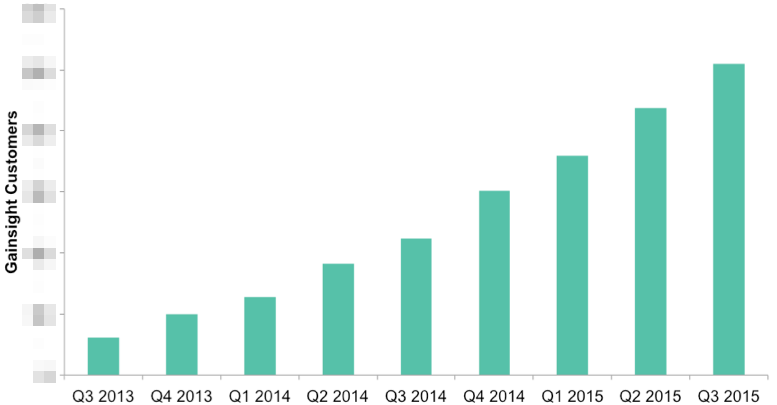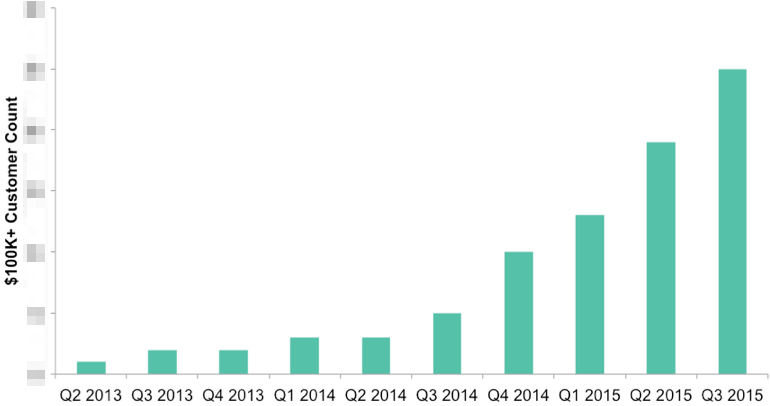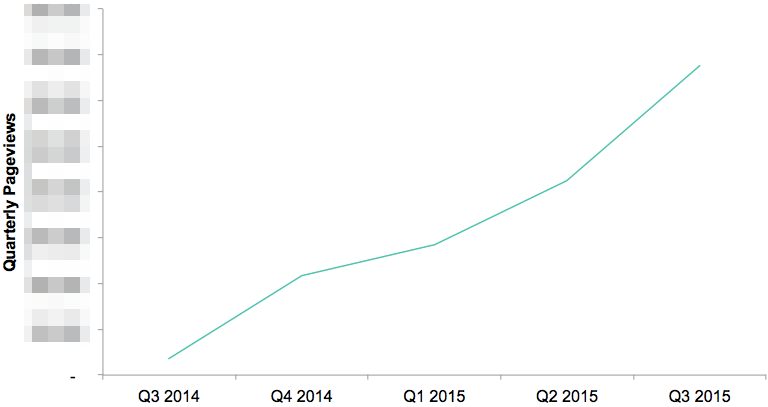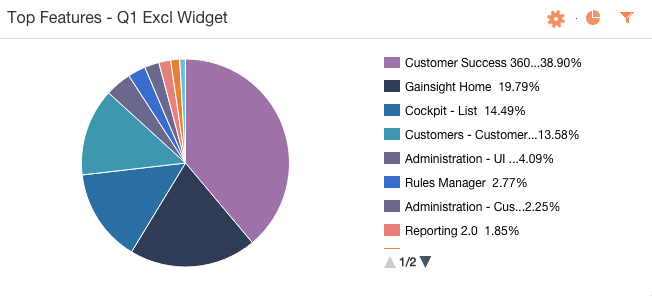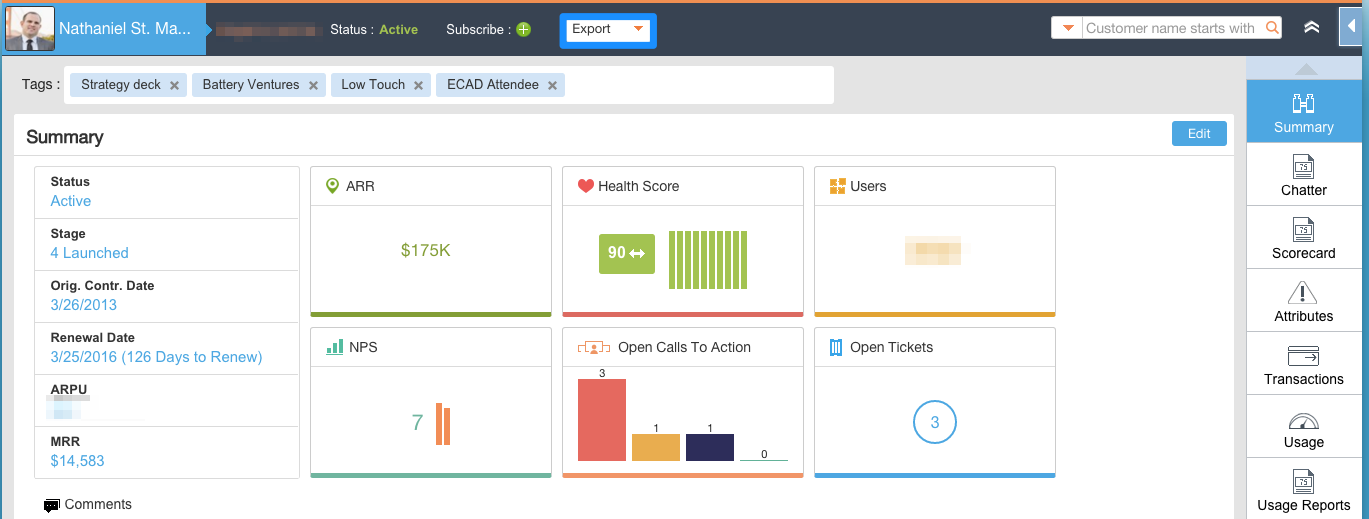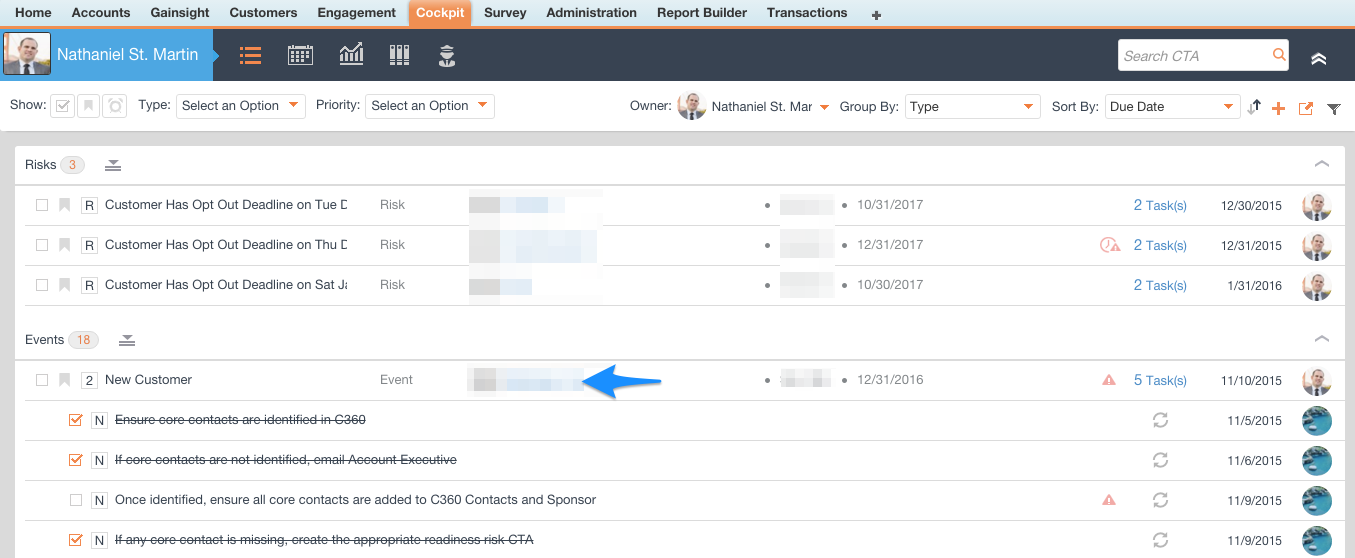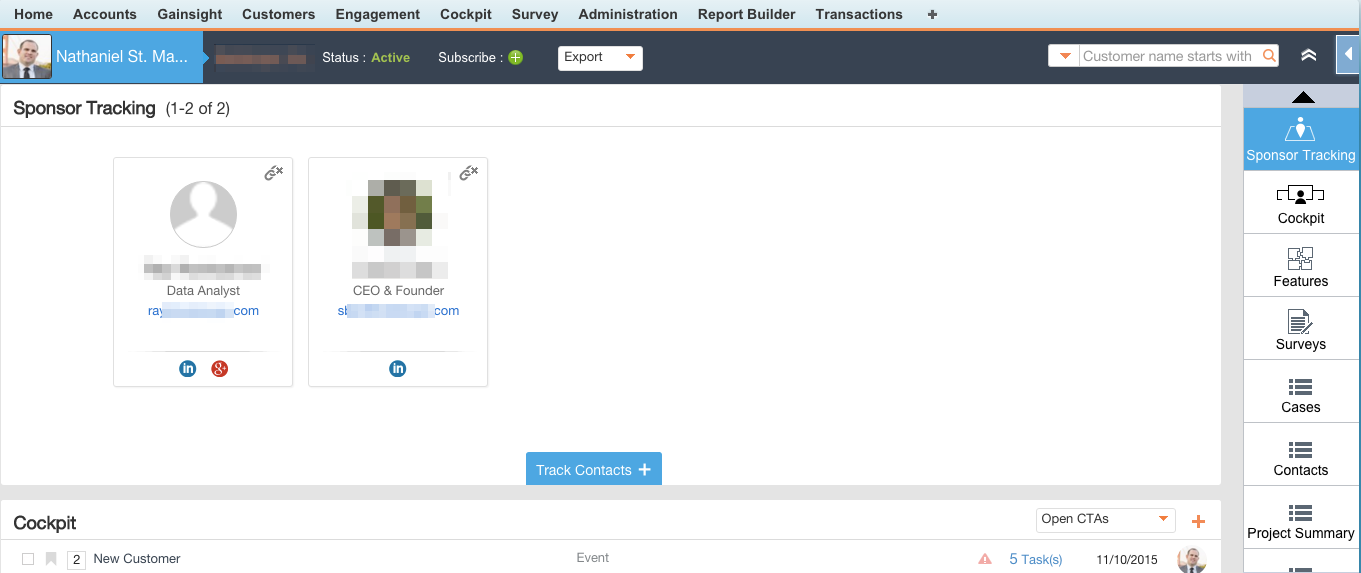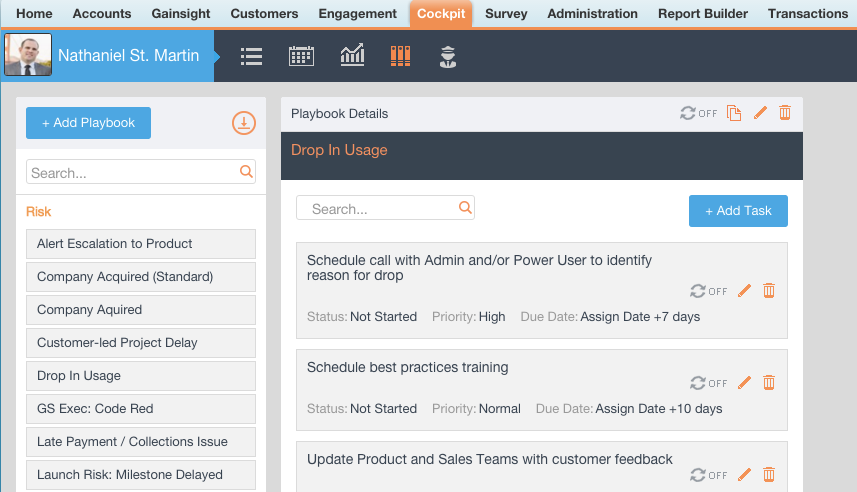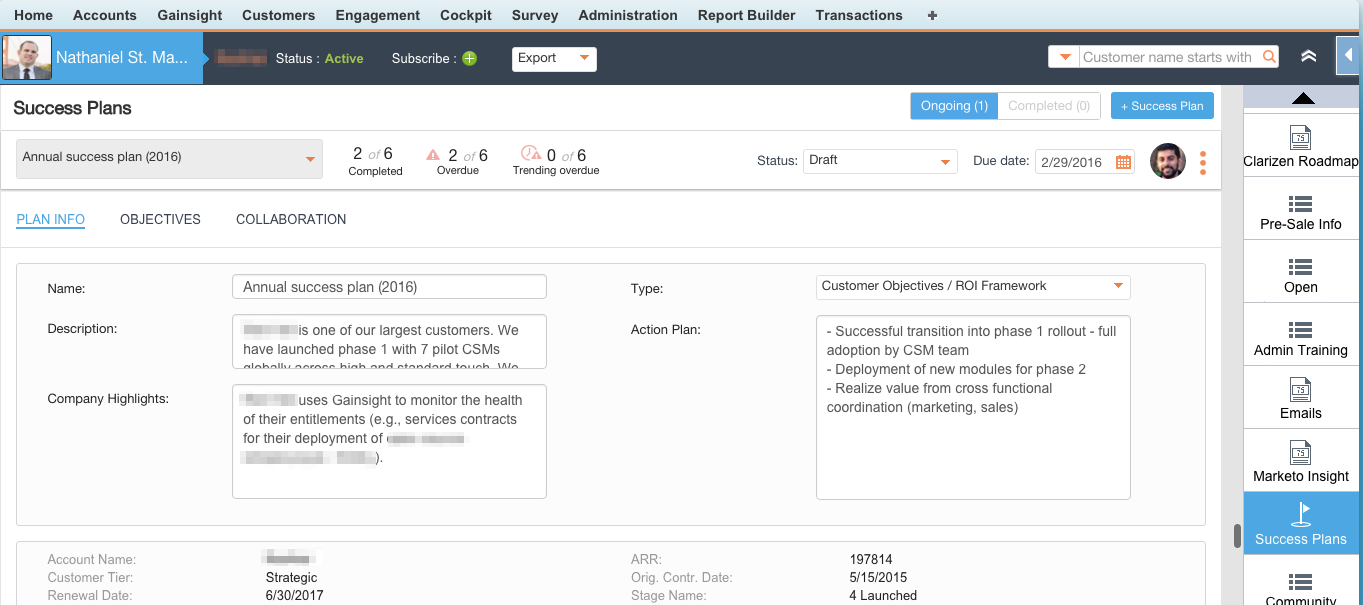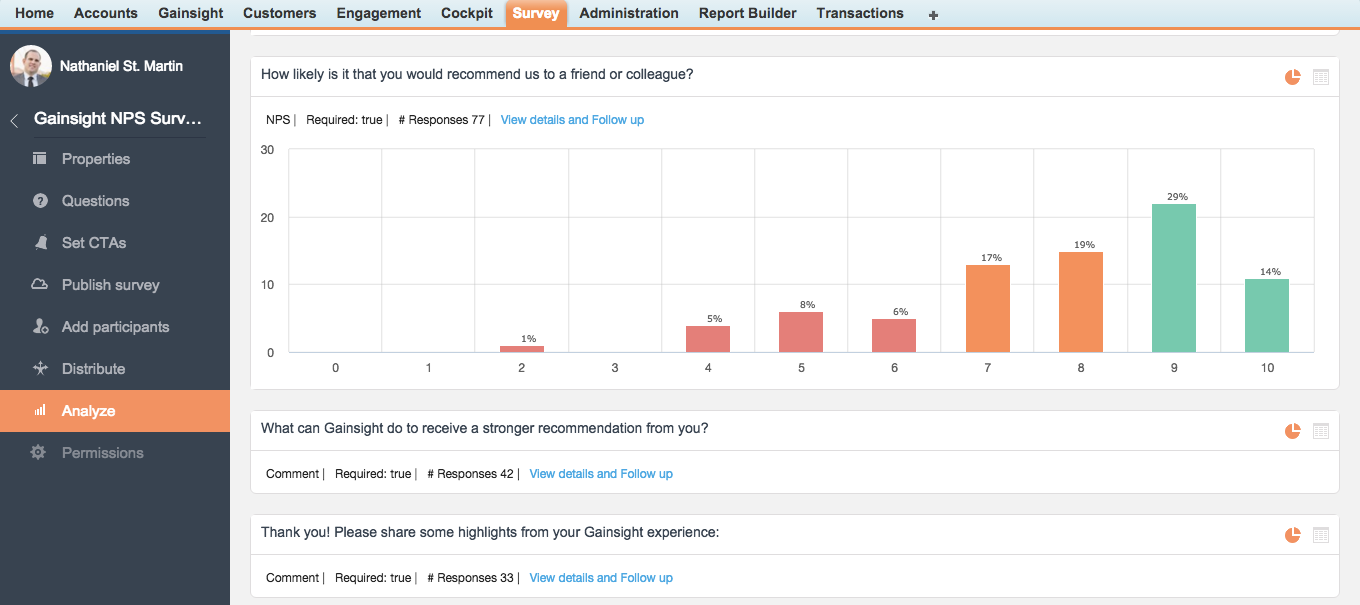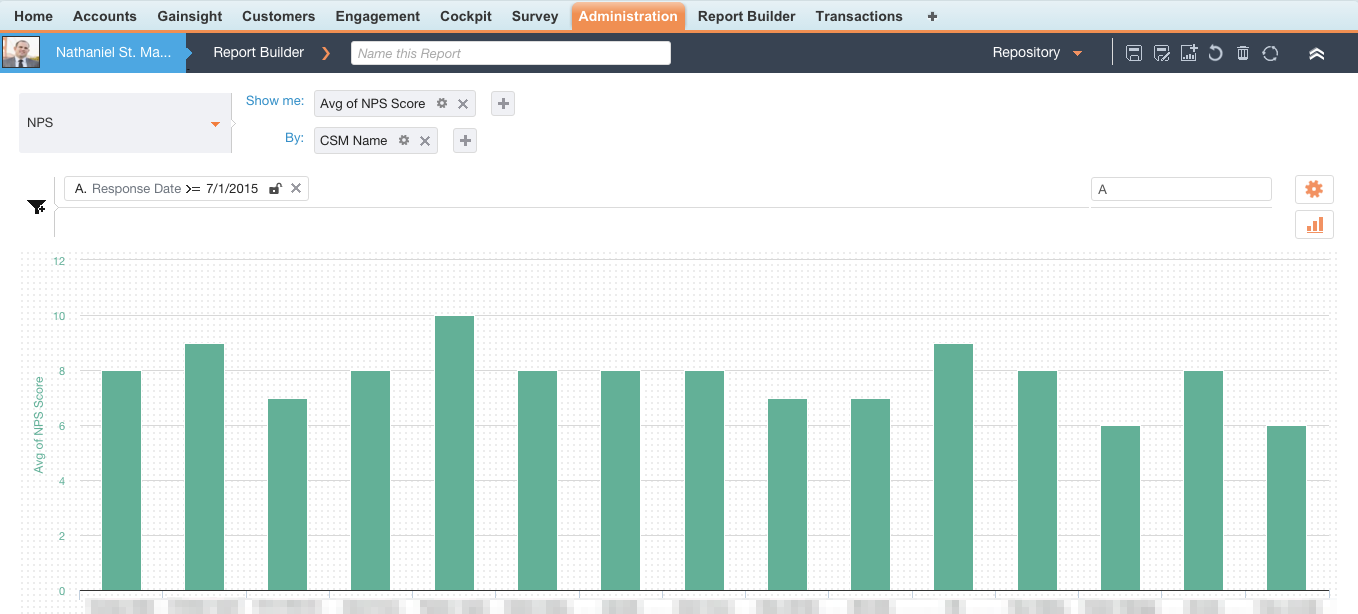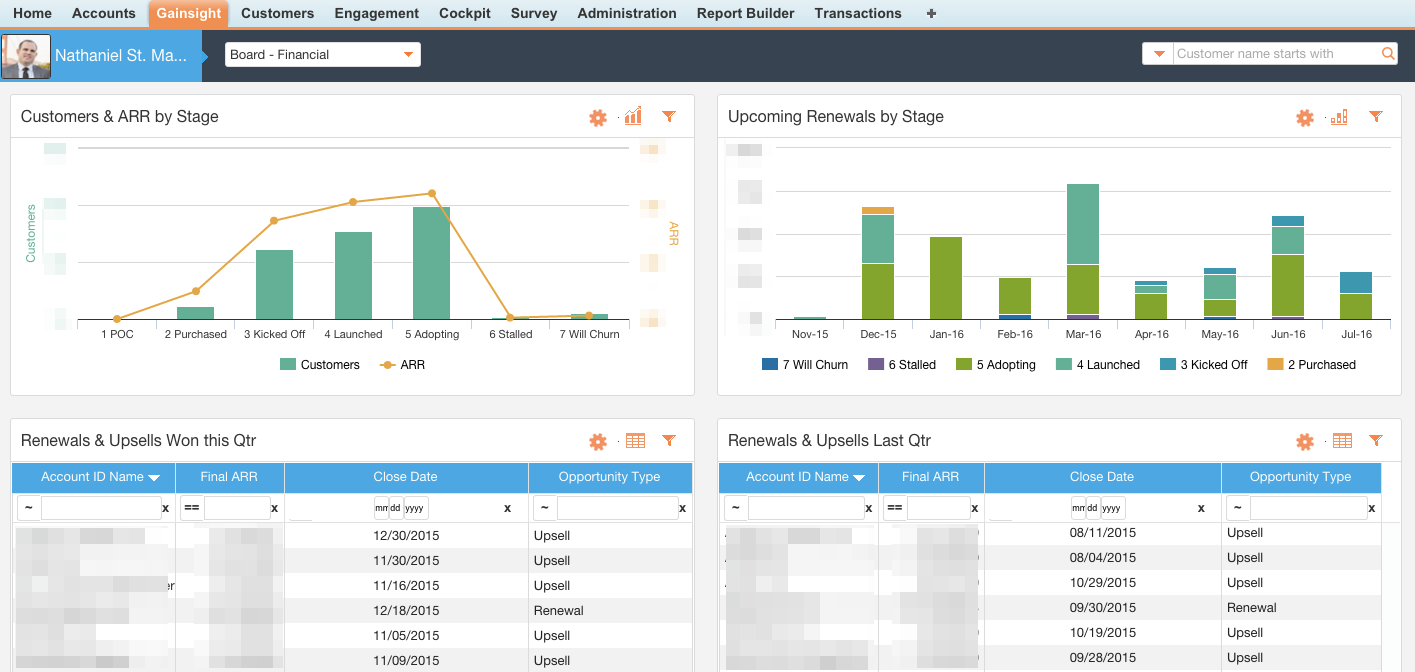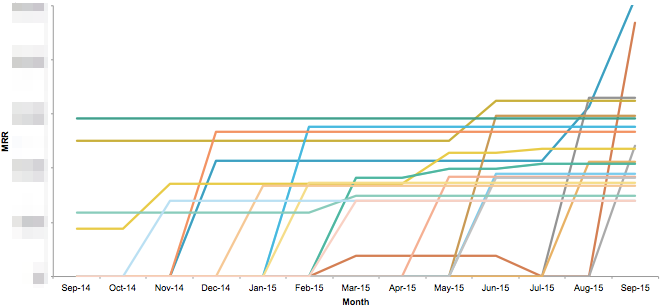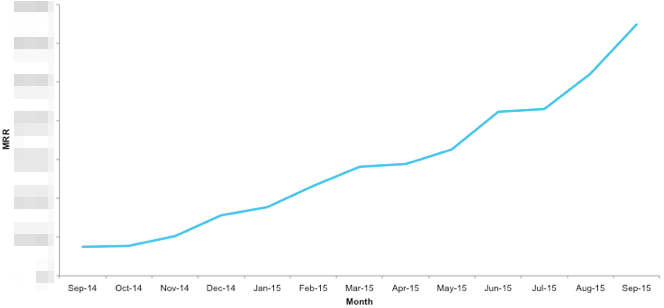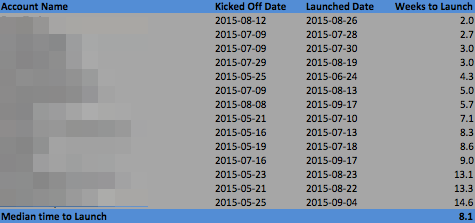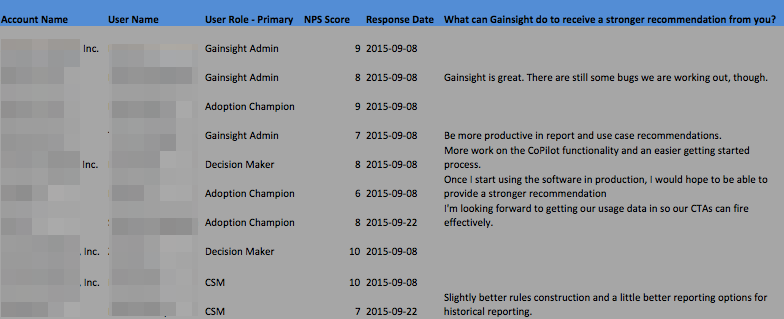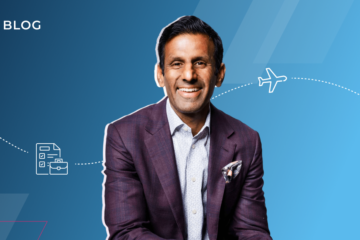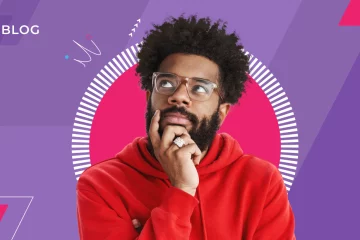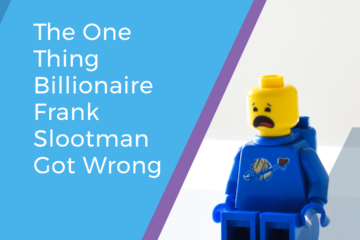
(The reports below are real but the data is blurred to protect the innocent…)
If you haven’t heard yet, we recently raised $50 trillionbillionmillion in Series D funding lead by Insight Venture Partners (there is a great article from Forbes about it here). And as I mentioned previously, the biggest story from the financing round is that it’s a testament to the Customer Success Movement going prime time.
As the stewards of the Movement, at Gainsight, we know that the road ahead of us is much longer than that from which we’ve come. But it’s still fun to reflect back on the early days – from our founder Jim Eberlin bootstrapping the company as JBara Software – to me joining as CEO in February 2013 and Battery Ventures investing when we had 10 customers and $120K in Annual Recurring Revenue – to our 260+ enterprise clients today. Not to mention a litany of cheesy music videos.
Between the widespread recognition of the new Customer Success category, our experienced team, market-leading product functionality and a favorable funding environment, we were fortunate to have our Series B (led by Bain Capital Ventures) and Series C (led by Bessemer Venture Partners) rounds of financing move from first meeting to signed term sheet in less than two weeks. And having been through a few startup booms and busts, I knew it wouldn’t always be that easy!
In our Series D funding process, I learned a few things:
- At the “growth” stage, it’s largely about metrics and market size (versus vision, team and product only)
- Investors really want to dive deeply into the metrics, so organization and preparation are critical
- My Chief of Staff (Nathan St. Martin) was a hero in terms of supporting this process – and helped write this post
- Our use of the Gainsight product was instrumental, end-to-end, in facilitating a smooth and effective fundraising process
- Growth rounds take longer (5 weeks versus 2 weeks for us, although that was still pretty fast)
8/12/2015: August Board Meeting
On August 12th, we had our quarterly Board Meeting to review our previous quarter’s results (Q2 ending 7/31/2015). We were fortunate to have had a great quarter – both in terms of new bookings as well as net retention. While we still had more than 1 year of cash in the bank, we all felt like the time was right to double down on the business and decided to start an early process to raise a Series D. In addition, the tech funding markets (private and public) were a bit turbulent and we wanted to make sure we were funded for the long haul and to build a big company.
Step 1: Reaching Out to Investors
On Sunday, August 23rd, as I watched some bad preseason football, I reached out to a dozen or so investors that knew Gainsight well to gauge their interest and get a feel for the market. I think I received about 10 replies in the next hour so my calendar blew up pretty quickly.
This was poor planning on my part, as I didn’t have an investor deck or diligence information (let alone a 2016 financial model) ready! I threw a presentation together and tried it a few times (with some success) but received great input from a close VC friend that “your deck looks like a Series A/B company – all about vision / team / product – when it should have been about metrics – you should own the fact that you’re a growth stage company.”
After a pitch review session with my existing Board (on September 10th in Boston right before we went as a team to see my Pittsburgh Steelers get beat up by the New England Patriots), my investors said it more succinctly: “you need more charts – you know the kind that go up and to the right!”
Based upon this, we decided to double down on using data in our process and made Gainsight the centerpiece for this. As you can imagine, we are hardcore users of Gainsight at Gainsight and (in our typical cheesywhimsical style) we have a nickname for the Gainsight instance of Gainsight – Gainsight On Gainsight or… wait for it… GonG. GonG helped us prepare for VC meetings, present to the firms, produce data for our pre-term sheet data room and facilitate the post-term sheet diligence process.
Step 2: Using Gainsight Leading up to the Investor Meetings
With the feedback from our board, we revamped the presentation with more slides on our momentum, success with our customers, and historical and projected growth and performance metrics. GonG was used to build many of the pages for the deck and we were able to show everything from the growth of our customer base and increased success with larger deals, to customer adoption and activity distribution across our features.
And to be clear, we didn’t just screen shot GonG and put it in our deck. Halfway through each pitch meeting, we logged into our Gainsight instance (or GonG) and said “we’re going to demo Gainsight to you – with our own data.” It was pretty powerful.
Below are some examples of the type of pages that were included in the deck along with brief explanations of how we leveraged GonG to produce them.
One way that we showed our strong performance to investors was by showing them the significant growth in our customer base in each quarter since I joined. To create this, we went to the Transactions tab in GonG, which is in our Lifetime Revenue Management feature. In this tab, we already have a table created to see our customer statistics over time.
We then created a graph to place in the deck:
The number of customers and the growth we’ve experienced is extraordinary, but an even bigger indicator of the market opportunity ahead of us is our penetration into larger companies. Getting a presence into these organizations is important for our long-term prospects as a company.
In order to show the momentum we have with enterprise companies, we created a page in the deck showing the growing number of customers we had with contract values over $100K in each of the last 10 quarters.
This report was created in Gainsight using a filter on the sum of the Annual Recurring Revenue (ARR) of our customers and the information was exported to create the graphic that was placed in the deck. We could have spent a lot of time during meetings convincing investors that we are the only enterprise-grade solution in the market, but the graph below is persuasive enough and gave us more time to focus on other topics.
One important topic that we covered in our deck, and in future diligence requests, is adoption by our customers. Since it is an important indicator to us, we have a dashboard in GonG dedicated to product adoption with many different reports that show the current state and trends over time.
We simply exported a couple of the graphs straight from the adoption dashboard as images and placed them into our presentation. We exported a graph that represents pageviews of the product by quarter, which we believe is a good measure of user adoption and growth.
We then exported a pie chart laying out the features being used the most by our customers, which was also part of the adoption dashboard. Analyzing the relative adoption and usage information across specific features is very useful, especially when considering when those features were launched or how complex they are.
At Gainsight, it is a priority for us to drive the customer success movement for all companies, but we also make it a goal to be the best customer success practitioners for our customers. Our success can partly be seen through our customer’s adoption patterns on our product, but third-party user review platforms are another indicator of how we are doing.
The ratings below obviously did not come from GonG, but we use GonG to identify successful customers and invite them to review us online – and have driven dozens of reviews in this fashion. These ratings were included in the deck to further validate the importance of being a customer-centric organization.
By having all of our customer data aggregated into one place, GonG saved us significant time as we constructed pages for the deck. Building the presentation was only a small part of the process though and even having the best deck cannot guarantee that investors will want to write you a check. Preparation is key and having the ability to dismiss any doubts that firms have during that first meeting will leave them wanting to know more.
In order to help investors relate to our product, we shared anecdotes of our customers that were also in their investment portfolios. Knowing that firms would ask their portfolio companies about us before we met, we made sure to get up to speed on each of those clients and brush up on their relationship with Gainsight.
Before each meeting with a firm, we looked at their portfolio companies to find all of their investments that are customers of ours. For each of those clients, we would spend a couple minutes reviewing their Gainsight Customer360 page in GonG to avoid getting caught off guard by any surprises; this review allowed us to quickly gather key information on mutual relationships.
Customer360 is our most popular feature because it gives users a holistic view of every one of their customers. To prepare for meetings, it was important for us to know the health of the customers, what stage they were in, and how long they have been clients of Gainsight. If more information was needed, all we had to do was scroll down or click on one of the tabs on the right side to get to more detail.
The investors enjoyed hearing about how their portfolio companies were doing and were impressed with our depth of knowledge of our clients.
Step 3: Demonstrating Value to Investors through GonG
We knew that the best way to prove the efficacy of our product was by showing investors how we use Gainsight across the company, so we tried to spend a good amount of time in GonG during each meeting. We found that by using GonG, the demo was much more natural as we discussed Gainsight’s actual customers and metrics as opposed to a make believe demo org. Where possible we had our VP of Product, Karl Rumelhart, lead the demonstration and show how the technology is used by different types of customers.
Gainsight is a complete customer success solution and we wanted to ensure that we highlighted most of our key features. Oftentimes, we would start in Cockpit, which is one of the most useful features for CSMs; this is the workflow and task management tab where users receive CTAs, or calls to action, prompting them to do something.
We showed investors how these CTAs are triggered when something is happening with a customer that requires action; these triggers could be a potential risk, a prospective opportunity, or a recurring event. A playbook, or set of tasks, is associated with the CTAs so the CSM, and others assigned to the tasks, know what course of action to take. These CTAs and tasks can be marked complete as they are performed so that the manager and other team members can have up-to-date information of the progress that is being made on the account.
I would actually bring up my view of Cockpit as a CEO, showing the Executive Sponsor check-ins I needed to do with our largest clients.
We then showed that for any given CTA, the CSM might need to access that customer’s Customer360 to complete the task or get more information on the customer in order to better assess the situation. To make it easy, anyone can click on the customer’s name and a separate tab will open to that customer’s Customer360. The blue arrow above is pointing to the name of the customer that links to the customer’s page below.
In this example, the task was to ensure that all core contacts are correct on the Customer360 page and added to Sponsor Tracking. During the demo, we could then click on “track contacts” to quickly add a core contact to Sponsor Tracking, which alerts users when a sponsor at their customer switches companies or roles. Everyone in the meetings agreed that it is extremely valuable to have the ability to track sponsors as they leave your customers or switch roles.
One of the most helpful parts of having CTAs for your team is the ability to have an associated playbook that lays out what steps need to be completed and when. In our meetings, we would display the ease and flexibility of playbooks by creating or updating one in GonG while discussing some of the best practices we’ve found through our experience and the experiences of our customers.
For example, when there is a significant drop in usage at a customer, we’ve found that following a three-step plan has worked the best to get customers back on the right track; the playbook below will automatically be triggered, which will help the team to quickly understand and mitigate the risk.
At Gainsight, we understand that not all our end users interact with their customers in the same way; therefore, we classify end users into three groups based off of their level of time commitment and interaction with their customers – an end user is either high touch, low touch, or tech/no touch.
Cockpit may not be the perfect solution for all types of end users, which is why we have been working on additional features for both high- and tech-touch CSMs. We recently came out with some innovative functionality for high touch CSMs and demonstrated these features in the investor meetings.
Since high-touch CSMs may only have a few customers, it is important for them to have a coordinated strategy and timeline with their clients. For this purpose, we would show Success Plans to investors. Success Plans live on the C360 page and give the user an area to record their strategy with that customer along with their plan of attack and progress made toward objectives.
We shared with investors that, like most processes that Gainsight is improving, this type of record historically lived in a Google Spreadsheet, or even worse, an Excel file saved to the user’s desktop where others in the company couldn’t see updates on progress or get smart on the strategy for the customer.
The collaboration functionality of Success Plans is especially helpful and allows teams to work together to help a customer reach a specific goal.
Teams of multiple people working together on one customer for long periods of time is not uncommon, but one of the most popular product topics amongst our customers and investors, is scaling customer success operations to the long tail of your customers.
Cockpit and playbooks help CSMs be more efficient, which allows them to have a higher ratio of customers, but completing tasks for individual customers becomes unmanageable at a certain point… like when a CSM is responsible for hundreds or thousands of clients.
If a CSM has a large portfolio of clients, she is most likely not expected to have frequent communications with those customers. This is an example of tech touch – relying on automated processes and technology to manage customers.
This functionality is important to many of our customers as they scale, which is why we developed Copilot and why we made sure to demonstrate it in our meetings. Copilot allows for automated emails to be sent when a milestone or risk occurs at a customer, freeing up resources that would have otherwise been needed.
Through Copilot you can also send an email to groups of your customers and then track whether or not customers opened the email or clicked on the link within the message, giving you additional visibility into customer’s habits. Whether it is sending customers notes on your latest product release or a quarterly NPS survey, Copilot enables you to communicate with large groups of customers at once.
If this were a point of interest for the investor we would spend some more time discussing the functionality and use cases of Copilot. We would show them how to create an email template to send to customers and demonstrate how to add a custom report to a template that could send each recipient a graph on their usage data.
For Gainsight customers, we could send them a breakdown of usage trends over time, or show them which features they are using the most relative to features that they are not using. Being able to show this depth of functionality helped us demonstrate the ability of our product team to quickly come out with worthwhile product updates. We mentioned that since Copilot was first released in May of this year, the team has acted on feedback from customers and evolved the product to include significantly more options and flexibility.
Discussing reports and surveys through Copilot naturally lead the dialogue to our functionality on those topics, and if it didn’t, we would try to make our way into these themes at some point in the meeting since they are particularly beneficial features.
NPS surveys, for example, are a very important part of our solution to many of our customers. The performance of some of our customers’ teams is evaluated off of NPS, so ensuring timely and accurate delivery of surveys is critical. We would show how we use Copilot to send NPS surveys to our customers and then monitor the responses through the Survey tab in GonG to analyze results. During the meeting, we were completely transparent and allowed investors to see actual NPS responses from a recent survey.
To understand the data better, we would click into different categories to get more granular or read respondent’s comments. When an investor asked who gave us a 2 and why, we clicked on the bar for that score to figure out who the detractor was and we were able to explain why the adoption champion at this customer was disappointed with her implementation.
We would also demonstrate the benefits of adding a CTA or follow up task directly from the surveys tab since NPS surveys are much more useful when acted upon. In this case, we would assign a playbook that we had success with in similar situations to the CSM on the account. The playbook is focused on addressing the customer’s concerns and turning her into a promoter and includes a task for Gainsight’s executive sponsor for the customer to reach out to confirm they are getting it resolved.
We could then build a report on NPS responses by CSM if it seemed relevant. Some managers use NPS as their major source of determining a CSM’s performance, while other managers may want to see which CSMs need their help the most. In the meeting, we could quickly pull up the average NPS score by CSM and apply a filter that only shows responses in the last three months to view the relative success and struggles of different CSMs.
Throughout the meeting, we would be flexible with the investor and would show them the features that were most relevant to their questions. The conversation usually included questions on our reporting or analytics tools, so we would go through a dashboard or two in GonG to show them how multiple reports can come together to tell a story. Showing them one of our dashboards for our Board of Directors made the most sense considering they are on the boards of other companies.
By giving demos through GonG, we showed confidence in our technology and helped investors see the ROI of our solution. After a few meetings, it became clear that using the product live was significantly more effective than trying to explain to every investor why the need for customer success management solutions is significant. Features like Cockpit and Customer360 immediately resonated with these industry veterans who had each felt the frustration of the inefficiencies of disjointed customer data and hectic customer operations.
After a few weeks, we had met with more than 25 firms whose fund strategies ranged from early-stage venture capital to growth-stage private equity and late-stage mutual funds. Some firms may not have seemed like the best fit on paper but we wanted to be inclusive in order to ensure that we found the investors that would become the best partners for Gainsight.
Showing our performance while also presenting product functionality and thought leadership impressed the investors enough that just about every firm wanted to learn more and perform initial diligence. The firms that decided not to proceed into diligence explained to us that we were not the right size or stage for them at this time.
The initial meetings were all about getting the investors interested; the majority of their analysis though was done after the fact where they dove headfirst into the data we provided and combed through it all to develop a thesis.
Step 4: Leveraging GonG to Deliver a Data Room Worthy of $50 MM
For the investors that were interested in digging into Gainsight a little deeper, we established a data room in Box where we gave them access to download the content. Our previous rounds were fairly light on diligence and did not require a lot of deliverables before signing the term sheet so building a data room was new to us. These later-stage investors though were not shy about asking for the information they wanted, so we populated the data room with their initial requests.
We started by organizing the requests into five folders: corporate documents, historical financials, projected financials, the investor deck, and a catchall folder for all of the data and metrics requests. We added a sixth folder after we opened the data room to investors for additional diligence requests.

- Corporate Documents: A number of investors asked for such things as our certificate of incorporation and governance documents early on so we uploading three files to this folder
- Historical Financials: Exported last 6 quarters of data from our financial management software
- Income Statement
- Balance Sheet
- Statement of Cash Flows
- Projected Financials: Uploaded XLS of our FY 2015 – FY 2019 (our fiscal year end is January 31st)
- KPIs, Cohort Analysis, and ROI Deck: The folder used for all performance data, metrics, and one off requests
- Sales Rep Performance: Provided performance of every account executive that’s ever worked at Gainsight by showing quarterly quota attainment for each rep
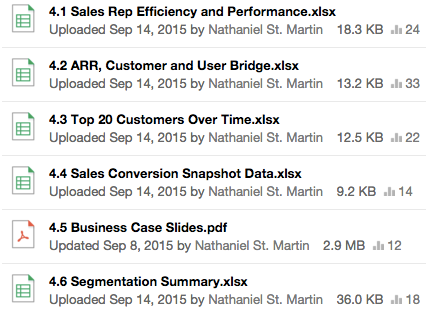
- ARR, Customer, and User Bridge: See below
- Top 20 Customers Over Last 12 Months: See below
- Sales Conversion Snapshot Data: Breakdown of conversions from names added to the database to accepted leads and closed deals (we only had two quarters of information though since we recently hired sales and marketing ops for the first time)
- ROI Deck: One investor asked for materials we use to pitch our ROI during sales cycles so we uploaded the business case slides that were custom built for a recent meeting
- Segmentation Summary: See below
- Sales Rep Performance: Provided performance of every account executive that’s ever worked at Gainsight by showing quarterly quota attainment for each rep
- Investor Deck: Uploaded the presentation used in the initial meetings
- Follow up Materials and Requests: Uploaded all of the deliverables from requests made after the data room was opened; if one investor asked for something, we shared it with all of the firms
- Actuals vs. Plan: Provided variance analysis pages from recent board decks
- Monthly Active Users by Monthly Cohort: See below
- Marketing Programs: Uploaded detailed spend on marketing programs that was not included in the projected financials deliverable
- Sales Pipeline: One investor wanted to see how our pipeline was dispersed across all of our account executives
- ARR by Monthly Cohort: Pulled data from GonG to be able to provide the recurring revenue by month for cohorts that were grouped by the month they first became a customer; this highlights the upsell and downsell by showing the Annual Recurring Revenue in August 2015 for all customers that signed in April 2014 (the output is similar to the monthly active user output below)
- B2B Customer Use Cases: Some investors wanted to better understand how some of our non-tech customers were using Gainsight
- Top 100 Customers: We previously only provided names and revenue for the top 20 customers and some investors wanted to see more
- Kicked-off to Launched Timing: See below
Once again, the product was used to help us efficiently create files that could be added to the data room. In this case though it was not for show and none of the investors would even know where we got the data; we simply used GonG because it was the easiest, cleanest, and most complete source of our data.
Through our Transactions tab in GonG we were able to immediately export a table that had an Annual Recurring Revenue, customer, and user bridge over our desired time period. For each quarter, we provided a break down of what went into getting us from the amount or number at the beginning of the quarter to the amount or number at the end of the quarter. For example, in any given quarter, the ending number of users is going to equal the number of users at the beginning of the quarter plus users from new customer and additional users from upsells to existing customers, less any reduction of users from existing customers and users from customers who churned in the quarter. Without Gainsight, this would have taken hours and most likely required gathering information from disparate data sources into Excel and running a number of pivot tables or V-lookups with the hopes of getting to the right numbers.
After exporting the key data from the Transactions tab, we added a couple of lines to calculate some key metrics using the data available, including net retention rate, ASP, and ARPU. The XLS was then ready to be uploaded to the data room.
Many investors also wanted to see our customer data by different cohorts to better grasp our performance metrics. One analysis that we added to the data room took the MRR of our largest 20 customers as of 13 months ago and tracked the growth in those same 20 customers over the next year.
We were able to get the data we needed through a report in GonG, export it as an XLS, and, after some formatting, upload it to the data room. The two graphs below show the growth within this cohort. On the left is each of the 20 customers represented by a different line and the one on the right shows the total combines MRR of the 20 customers over the 13 months and how the cohorts MRR significantly grew in just over one year.
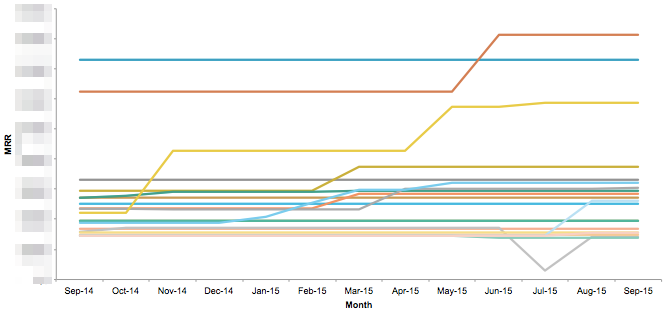
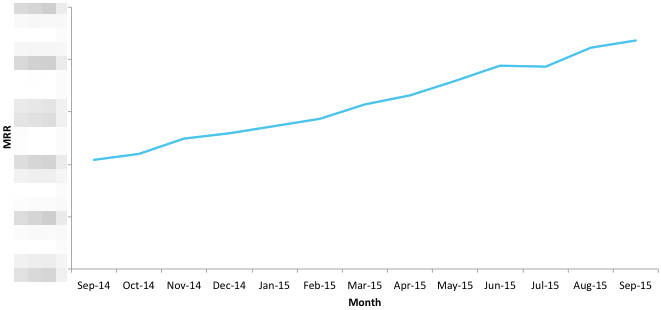
In that same analysis, we also looked at our top 20 customers from the previous month (September 2015) and looked back to 13 months prior to see how many of our top 20 customers were signed in the last year. In the graph on the left, you will see that only 4 of our top 20 clients from September 2015 have been customers for at least a year (since we are closing larger customers every quarter).
Upsells were especially interesting in this cohort as some customers got into the top 20 during the time frame by realizing the value of Gainsight at a small scale before making a bigger investment in the solution. Upsells at some of our largest accounts happened multiple times within the last year as these accounts roll out the product to different teams or product lines – a promising sign of things to come as we sign more enterprises.
Another piece of data that we uploaded to the data room was a summary of the segmentation of our customers. In order to get this summary, we used GonG to build a report of all of our customers along with key data points on each customer. We wanted to export a table of all of our customers that listed their segment and industry in addition to their ARR and # of licensed users. By adding a couple filters on the report, we were able to exclude any account that was not a customer at the beginning of Q3.
Once this table was created with all of the data above, we were able to run a couple of “SUMIF” statements in Excel to get to a summary by segment. We were able to do a similar summary based off of industry as well. For segment, we only have three options: SaaS, Enterprise Software or Hardware, or Other B2B.
We did not include every type of analysis possible in the data room, but we gave investors enough to get a better idea of Gainsight as a company and to pique their interest if they were truly interested in investing.
A number of investors bowed out after gaining access to the data room for different reasons – some couldn’t expedite their diligence to fit our schedule, while others didn’t buy into, or understand, the big potential size of the customer success space. Most investors though wanted more information and continued to request additional pieces of data.
Step 5: Fulfilling Final Diligence Requests
Some investors came back with more diligence requests and we continued to leverage Gainsight to produce timely and accurate deliverables. Without the use of GonG, we would have had to devote more of our resources to gathering this information and completing diligence requests.
One investor requested some supplementary data on product adoption and wanted to see trends in our customer base off of the month that they first became a customer. We first pulled the data from GonG by running a report on the number of monthly active users by account.
We then separated the customers into cohorts by the month they became a client. All of this data was then summarized into a table to show how monthly active users have grown within their cohorts. A similar analysis was done on ARR to show the effects of upsell, downsell, and churn to the different cohorts.
Another request wanted to see more data on how long it took our customers to be fully implemented. In GonG, we track milestones of our customers in order to have the full story when we need to know anything and two of the milestones we track are when implementation kicked off and when the customer was fully launched. For this request, it was easy for us to pull data by customer on how long it took each of them to launch after their kick off date.
Once we ran the report, we exported the data to an XLS, added a column for time to launch and calculated the median before uploading the data to Box. Below is a subset of that data.
Thankfully, for all parties involved in our Series D, GonG produced quality information saving our team a lot of time. There were many requests that came in during the diligence process that only required a few clicks within Gainsight to produce, which were extremely rewarding to construct through the product. Other requests were more sophisticated and required some extra configuration before running the report, or needed manual work after exporting all of the data, but in the end we were able to generate everything that was needed.
Step 6: Evaluating Term Sheets
In order to keep the process moving and ensure we were spending our time with the firms that were the best mutual fit, we asked for all term sheets to be submitted by the end of September. This time frame gave most investors a couple of weeks to digest the information from the data room and ask any follow up questions, while some firms had as little as a week to do their diligence since they weren’t able to schedule a meeting for the previous couple of weeks.
On September 28, five weeks after I first reached out to a handful of firms, we received term sheets from the most interested parties. After receiving the proposals, we discussed the options with our board and made sure we were all on the same page. We weighed the pros and cons of each offer, analyzed the terms, evaluated the investment team’s expertise, and examined each firm’s investment portfolio and stage preferences.
When it came down to it though, all of those things, including proposed valuation, didn’t factor into our decision as much as the potential of the partnership with the Insight Venture Partners team. Jeff Lieberman and his team were sold on customer success early on (a number of Insight portfolio companies use Gainsight) and they understand how important an existing customer base is to long-term profitability and sustained topline growth. In addition, Insight moved the fastest by far in the process. We signed the term sheet with Insight on October 3rd.
Step 7: Striking the “GonG” on our Biggest Deal Yet
Between signing the term sheet and the funds hitting our bank account, final diligence needed to be completed. We tried to complete this diligence in just a couple of weeks and all parties agreed to make it happen. Our Controller and law firm handled the legal and accounting diligence, which was the bulk of the work after signing the term sheet.
One piece of diligence that Insight said it does with all of its investments was a customer survey to get a better idea of how customers view the company and product. Luckily we survey our customers regularly, so this wasn’t an issue. We ran a report in GonG to get the results and applied a filter to provide responses by quarter for the last year.
By including the role of the person who provided the response, we gave Insight the ability to see how every level at our customers, from decision makers to end users, views Gainsight.
One of the final pieces of the diligence and fundraising process as a whole was a daylong in-person session where the Insight team met with each of our organizations and executives at Gainsight. It was great to have our new investors at the offices in Redwood City, and we introduced them to the whole company at our weekly all hands meeting.
The discussion during our in-person sessions with the Insight team continued to be centered upon the product and our customers. Our customer success organization showed how using the product to operationalize the team keeps them focused on the success of our customers, which leads to more favorable financial and operating metrics for the company. The sales team talked about how our strong customer base is helping them gain momentum with some of their prospects and the product team spent time discussing our roadmap and how customer feedback and needs are evaluated to prioritize projects.
Seeing the advantages of being a customer-centric organization, our VP of Customer Success, Allison Pickens, recently documented the best practices on making customers the center of the company and wrote a blog post on the potential for other departments to work with the customer success team. Each of our organizations knows our customers well and views them as the center of our success, and by doing so, everyone benefits from the strength of our customer base.
Conclusion
At the end of the day, we were able to raise our Series D because of:
- The Customer Success movement and the thousands of people in the profession
- Our customer base of Customer Success pioneers and leaders
- High-velocity innovation in our product
- Our passionate and experienced team
- Finding an investor that saw all of the above
But being organized and being able to confidently talk about our customers and their success, using Gainsight, helped tremendously. And as more investors get savvy to the importance of Customer Success to business success, I suspect they will want to continue to dive more into the success metrics for their potential investments. Here’s to your success!

